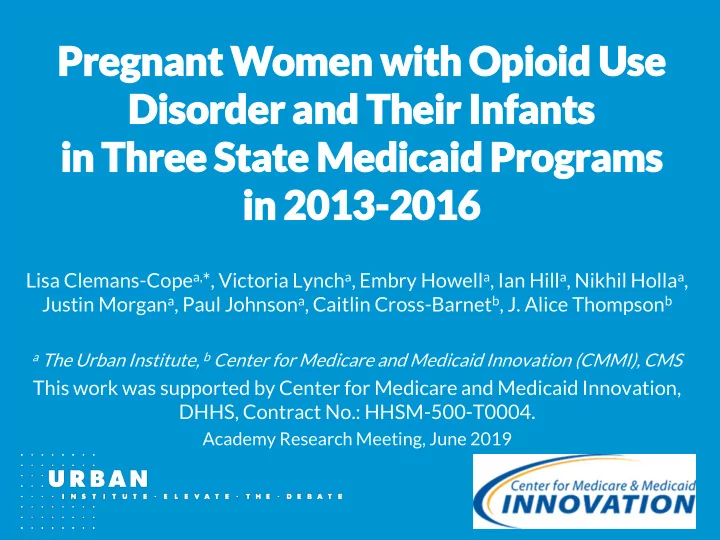

Pregnant Women with Opioid Use Disorder and Their Infants in Three State Medicaid Programs in 2013-2016 2016 Lisa Clemans-Cope a, *, Victoria Lynch a , Embry Howell a , Ian Hill a , Nikhil Holla a , Justin Morgan a , Paul Johnson a , Caitlin Cross-Barnet b , J. Alice Thompson b a The Urban Institute, b Center for Medicare and Medicaid Innovation (CMMI), CMS This work was supported by Center for Medicare and Medicaid Innovation, DHHS, Contract No.: HHSM-500-T0004. Academy Research Meeting, June 2019
Preview of the main finding: Few pregnant women with opioid use disorder are receiving consistent treatment in Medicaid • Women with OUD who are pregnant and parenting did not receive consistent treatment when enrolled in Medicaid. • In a typical month in the year before and year after birth, most Medicaid-enrolled women with OUD received no addiction-related treatment.
Data and study sample • We linked maternal/infant Medicaid claims/payment and infant birth records in 3 states 2013-2016 to examine health care use, treatment, neonatal outcomes in the year pre/post birth for mothers with opioid use disorder (OUD) and other substance abuse disorders (SUDs) • Sample included women with Medicaid claims data who delivered a live singleton infant in 2014 or 2015 • Sample size was 37,782 for 2014 (9k, 12k, and 17k across the 3 states) and 34,304 for 2015 (8k, 10k, and 15k across the 3 states). • Classified women as having an SUD/OUD based on an adaptation of the EMSANT-W, a population-based SUD identification tool tailored to women of reproductive age (Derrington et al., 2015) with ICD-9/ICD-10 • Outcomes: health care utilization, expenditures, SUD treatment by type and consecutive months of treatment, and neonatal outcomes.
SUD & OUD and treatment among sample mothers in the year pre/post birth SUD & OUD: • Most Medicaid enrollees in the sample had no SUD (92%) • 2% percent of the sample had an opioid use disorder (OUD) diagnosis • 6% of the sample had a SUD diagnosis other than OUD Treatment: • 73% of women with OUD had some type of SUD treatment pre/post birth • But -- most had no treatment in an average enrolled month • 9% received methadone treatment in an average enrolled month
Prenatal care & Perinatal outcomes • Pregnant women with OUD had delayed and lower rates of prenatal care compared to women with other SUDs. • Rate of preterm or low birth weight did not differ between infants of mothers with OUD and those with other SUDs. • Compared to infants of mothers with other SUDs, infants of mothers with an OUD had: • higher rates of admission to NICU • longer birth hospitalizations • more infant drug/alcohol diagnosis.
Health care costs in the year pre/post birth for women with OUD and SUD and their infants • Delivery month/hospitalization costs were $22k for women with OUD, $16k for those with another SUD, and $11k for those without an SUD. • Costs for women with an OUD were particularly high in the period after birth. • Health care costs before and at delivery were higher for women with methadone treatment than for women with OUD and no treatment. • Higher costs may be related to the treatment itself or because these women were experiencing higher health care needs.
Study limitations • Administrative health care data; lack of detail in the claims data; • Not able to observe key treatment characteristics such as medication dose and any SUD treatment not covered by Medicaid; • Based just on three states, limits the generalizability of the findings to other states; • Data excluded women or infants who died before delivery or at delivery, precluding examination of mortality outcomes; • Non-experimental nature of our study design precludes causal interpretations.
What did we find out about health care use and costs of pregnant women with opioid use disorder and their infants? Our analysis of maternal and infant Medicaid claims data and infant birth • records in three states shows low treatment rates, delayed prenatal care, high NICU use, and high health care costs among mothers with OUD and their infants. Initiation & support of evidence-based treatment during birth • hospitalization could improve outcomes & cost, but may depend on provider/patient attitudes/knowledge of effective treatment There is an urgent need for comprehensive, evidence-based OUD • treatment integrated with maternity care.
Recommend
More recommend